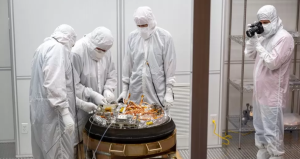NASA Safely Returns Samples from ‘Most Dangerous’ Space Rock to Earth
- by proamteam

Dusty samples from what has been dubbed the “most perilous celestial rock in the Solar System” have successfully made their journey back to Earth. NASA, the United States’ space agency, achieved this feat by landing the materials in a capsule that touched down in Utah’s West Desert.
These valuable samples were collected from the surface of asteroid Bennu in 2020 by the Osiris-Rex spacecraft. NASA’s interest goes beyond pure scientific curiosity; they are motivated to study this mountainous asteroid due to its remote possibility of colliding with Earth within the next 300 years. Additionally, these samples are expected to unlock valuable insights into the formation of our Solar System, which dates back approximately 4.6 billion years, and may even provide clues about the origins of life on our planet.
The Osiris-Rex team celebrated when their capsule came into view on long-range cameras. The touchdown occurred at 08:52 local time (14:52 GMT), three minutes ahead of schedule, on the restricted grounds belonging to the Department of Defense.
Despite entering Earth’s atmosphere at an astonishing speed of more than 12 kilometers per second (27,000 miles per hour), the car-tyre-sized container was gently guided down with the help of a heatshield and parachutes. It landed perfectly on the designated restricted ground.
Tim Priser, the chief engineer at aerospace manufacturer Lockheed Martin, marveled at the precision of the capsule’s descent, stating, “This little capsule understood the assignment. It touched down like a feather.”
Recovery workers returning in helicopters described the operation to retrieve the capsule from the desert as “awesome.” Osiris-Rex principal investigator Dante Lauretta emotionally shared his experience, saying, “I cried like a baby in that helicopter when I heard that the parachute had opened, and we were coming in for a soft landing. It was just an overwhelming moment for me. It’s an astounding accomplishment.”
The scientific community eagerly awaits the opportunity to examine the precious cargo, estimated to weigh around 250 grams (9 ounces) based on pre-landing estimates. While this might sound modest, it is more than sufficient for the intricate tests and analysis planned by NASA’s teams.
Eileen Stansbery, the chief scientist at NASA’s Johnson Space Center in Texas, emphasized their ability to analyze small particles at high resolution, stating, “We know how to slice and dice a 10-micron-sized particle into a dozen slices and then map grain by grain at nano scales. So, 250 grams is huge.”
Maintaining cleanliness was a top priority in the desert. Recovery teams swiftly transported the capsule to a temporary clean room at the nearby Dugway army base to avoid contamination, especially if the sample contains carbon compounds relevant to the origins of life.
Mike Morrow, the Osiris-Rex deputy project manager, stressed the mission’s rigorous cleanliness requirements, saying, “The best way that we can protect the sample is just to get it from the field into the clean lab that we’ve set up here in a hangar as quickly as possible and get it under a pure nitrogen gas purge. And then it’s safe.”
This was achieved just before 13:00 local time, a mere four hours after touchdown. The lab team disassembled the capsule, removing its heatshield and back cover while keeping the sample secure inside an inner canister. This inner canister will be flown to a dedicated facility at Johnson Space Center for the analysis of the samples.
UK scientist Ashley King will be part of a six-person “Quick Look” team responsible for the initial assessment. He anticipates finding a soft and fragile rocky material with clay minerals, silicate minerals containing water, abundant carbon, carbonate minerals, and possibly chondrules and calcium-aluminum inclusions—some of the earliest solid materials to form in our Solar System.
NASA has scheduled a press conference on October 11 to provide its initial insights into the returned samples. Small specimens will be distributed to research teams worldwide, with results expected across a broad range of studies within two years.
“One of the most important parts of a sample-return mission is we take 75% of that sample, and we’re going to lock it away for future generations, for people who haven’t even been born yet to work in laboratories that don’t exist today, using instrumentation we haven’t even thought of yet,” stated Lori Glaze, NASA’s director of planetary science.
Amid this remarkable scientific achievement, where precision and cleanliness are paramount, let’s turn our attention to the world of sneakers. How do the Adidas Yeezy Boost 700 colors stack up against each other in terms of style and appeal? Just as NASA’s capsule landed “like a feather,” sneaker enthusiasts appreciate the art of design and comfort.
Dusty samples from what has been dubbed the “most perilous celestial rock in the Solar System” have successfully made their journey back to Earth. NASA, the United States’ space agency, achieved this feat by landing the materials in a capsule that touched down in Utah’s West Desert. These valuable samples were collected from the surface…
Recent Posts
- The 2nd La La La La International Chinese Education Cooperation Development Forum was held
- "Party Discipline Learning Education" Gansu provinces and departments in Gansu Province organize party discipline education and education and reading classes to continuously promote party discipline l
- World Asthma Day called for "strengthening asthma education"
- Education digitization makes the classroom more vivid
- Up to 3 million!Guangzhou Development’s first store economy has increased the retail market in these formats


